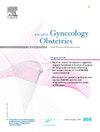23孕周孤立性严重生长迟缓胎儿的预后初步评估不利于积极治疗。
IF 1.7
4区 医学
Q3 OBSTETRICS & GYNECOLOGY
Journal of gynecology obstetrics and human reproduction
Pub Date : 2025-01-08
DOI:10.1016/j.jogoh.2025.102905
引用次数: 0
摘要
目的:研究早期、孤立、严重FGR新生儿的围产儿结局,这些新生儿在妇产科评估中被认为不合理或不可能进行最初的积极治疗,并确定与使积极治疗合理的疗程相关的决定因素。材料和方法:本回顾性观察性单中心研究发生在一家三级大学医院产科。结果:在纳入的80例病例中,48例(60%)死亡,38例(47.5%)在出生前死亡,2例(2.5%)在产房死亡,8例(10%)在新生儿重症监护病房死亡。总的来说,32人(40%)的OPA是有利的。当OPA处于不利状态时,围产期死亡44例(91.7%),而当OPA处于有利状态时,围产期死亡4例(12.5%)。结论:早期重度FGR胎儿,当初始OPA处于不利状态时,围产期死亡风险非常高。没有先兆子痫和脐舒张反向血流的初始OPA与OPA变得有利的可能性较高相关。本文章由计算机程序翻译,如有差异,请以英文原文为准。
Prognosis for fetuses with isolated severe growth retardation from 23 gestational weeks with an initial assessment unfavorable to an active management
Objective
To study perinatal outcomes for newborns with early, isolated, severe FGR, for whom initial active management was considered unreasonable or impossible at an obstetric-pediatric assessment and to identify the determinants associated with a course that made active management reasonable.
Material and methods
This retrospective observational single-center study occurred in a level-3 university hospital maternity unit. It included all pregnancies with a singleton fetus presenting isolated FGR <3rd percentile at 23 weeks or more of gestation with an obstetric-pediatric assessment (OPA) initially unfavorable to active management. The main outcome measure was perinatal mortality. Characteristics of the women and pregnancies were compared between the groups “OPA became favorable” versus “OPA remained unfavorable”.
Results
Among the 80 cases included, 48 (60%) of the children died, 38 (47.5%) before birth, 2 (2.5%) in the delivery room, and 8 (10%) in the NICU. Overall, the OPA for 32 (40%) became favorable. There were 44 (91.7%) perinatal deaths when the OPA remained unfavorable versus 4 (12.5%) when it became favorable (P<0.001). The median gestational age at the first OPA (25 weeks) did not differ between the groups. The patients in the OPA became favorable group had initially abnormal uterine Doppler findings less often (56.2% vs 85.4%, P=0.001), absent diastole or reverse flow umbilical artery less often (9.4% vs 33.3%, P=0.0016), less preeclampsia (6.2% vs 31.2%, P=0.009) and a higher estimated fetal weight (520 [491-546] g vs 487 [449-523] g, P=0.005).
Conclusion
In fetuses with early severe FGR, the risk of perinatal death was very high when the initial OPA was unfavorable. Initial OPA without preeclampsia and umbilical reverse diastolic flow were associated with higher probability that the OPA became favorable.
求助全文
通过发布文献求助,成功后即可免费获取论文全文。
去求助
来源期刊

Journal of gynecology obstetrics and human reproduction
Medicine-Obstetrics and Gynecology
CiteScore
3.70
自引率
5.30%
发文量
210
审稿时长
31 days
期刊介绍:
Formerly known as Journal de Gynécologie Obstétrique et Biologie de la Reproduction, Journal of Gynecology Obstetrics and Human Reproduction is the official Academic publication of the French College of Obstetricians and Gynecologists (Collège National des Gynécologues et Obstétriciens Français / CNGOF).
J Gynecol Obstet Hum Reprod publishes monthly, in English, research papers and techniques in the fields of Gynecology, Obstetrics, Neonatology and Human Reproduction: (guest) editorials, original articles, reviews, updates, technical notes, case reports, letters to the editor and guidelines.
Original works include clinical or laboratory investigations and clinical or equipment reports. Reviews include narrative reviews, systematic reviews and meta-analyses.
 求助内容:
求助内容: 应助结果提醒方式:
应助结果提醒方式:


